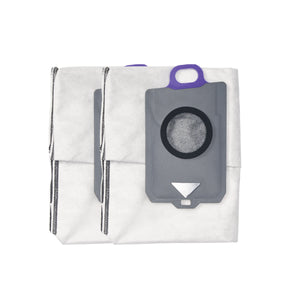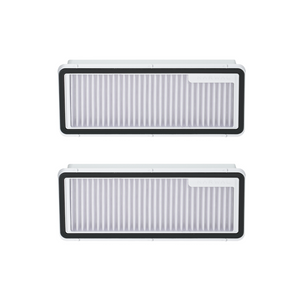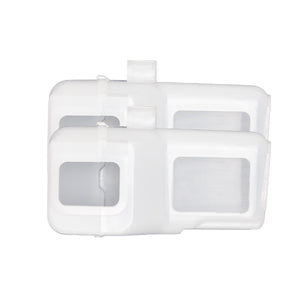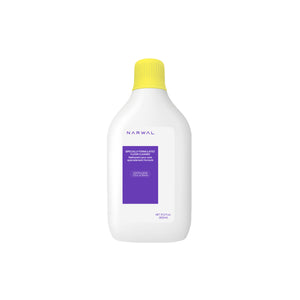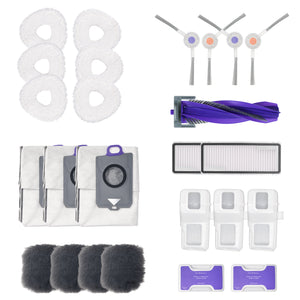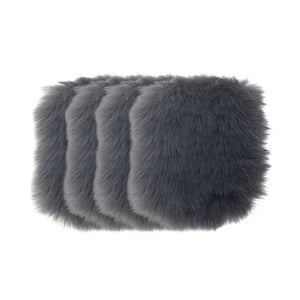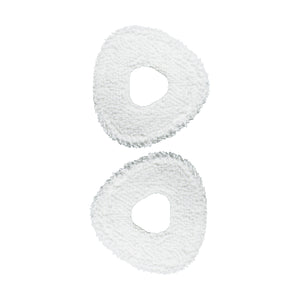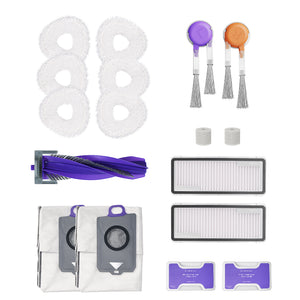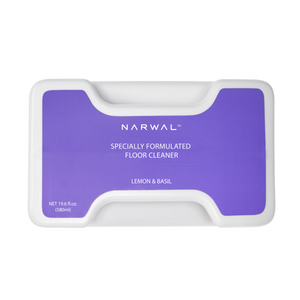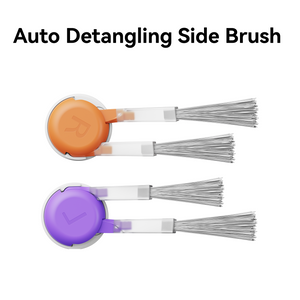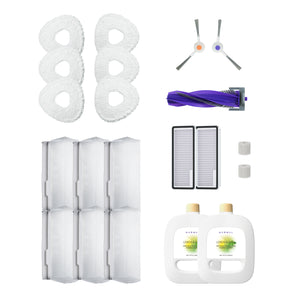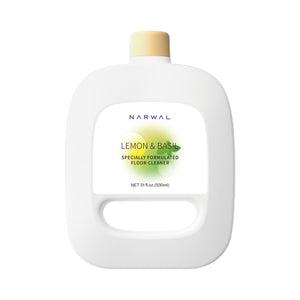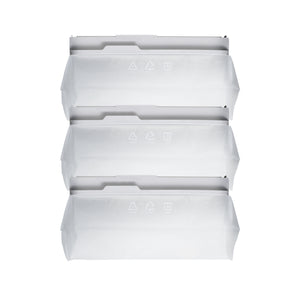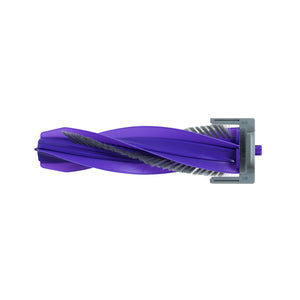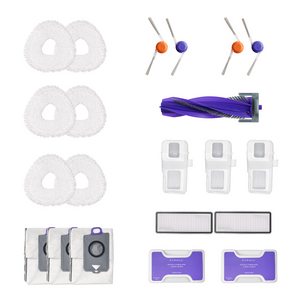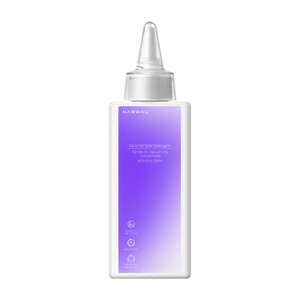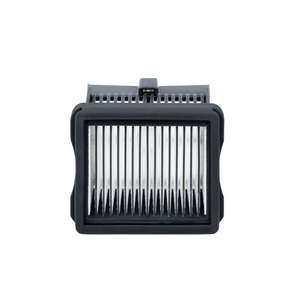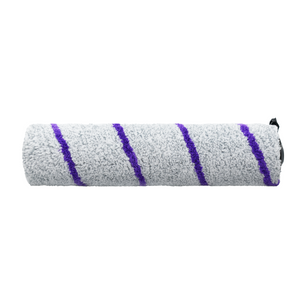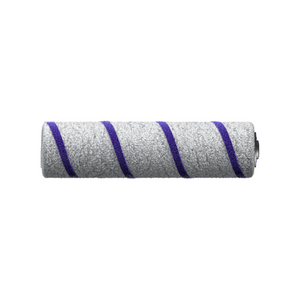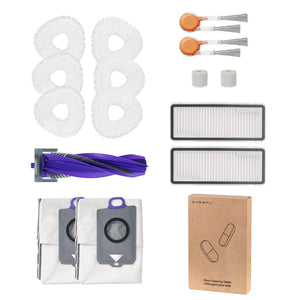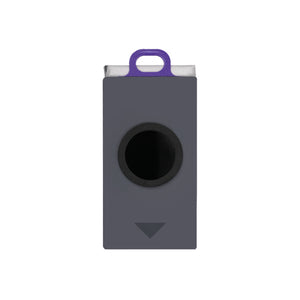Wondering whether a dust mop or a vacuum is better for your hardwood floors—or for handling pet hair?
This guide breaks it down. You’ll see a side-by-side comparison, learn how each tool works, and discover which one wins for deep cleaning, convenience, cost, and health. We’ll also cover family and floor type scenarios, plus a simple routine for using both together. By the end, you’ll know exactly which tool fits your home and lifestyle.
Dust Mop vs Vacuum Cleaner: Quick Comparison
If you're choosing between a dust mop and a vacuum, here's a quick side-by-side overview across all the key factors. You’ll find detailed breakdowns in the sections below.
|
Category |
Dust Mop |
Vacuum Cleaner |
|
Cleaning Method |
Manual sweeping with static microfiber pad |
Motorized suction pulls dirt into a filter system |
|
Deep Cleaning Ability |
Light surface dust only |
Removes embedded dirt, allergens, pet hair |
|
Best For |
Quick cleanups on smooth hard floors |
Full cleanups on mixed floors or high-traffic zones |
|
Air Filtration |
None |
Often includes HEPA or sealed filters |
|
Noise Level |
Silent |
Moderate to high (depends on model) |
|
Ease of Use |
Lightweight, grab-and-go |
May require setup, attachments, or battery charging |
|
Storage |
Slim, hangs easily |
Requires more space and cable management |
|
Cost of Maintenance |
Very low |
Medium to high, depending on parts and upkeep |
|
Eco-Friendliness |
No energy use, reusable pads |
Uses electricity, produces filter/bag waste |
|
Who It’s For |
Small homes, light messes, quiet cleaning |
Families with pets, allergies, or varied surfaces |
What Is an Electrostatic Dust Mop?
An electrostatic dust mop is a cleaning tool that uses static electricity to attract and hold dust, dirt, and hair. Unlike traditional mops that rely on moisture or scrubbing, this type of mop works dry—making it ideal for hardwood, laminate, and other sealed floors.
The static charge builds up as you move the mop across the floor. This charge pulls in fine particles like dust, pet hair, and even pollen, holding them in the microfiber pad until it's cleaned or replaced.
Compared to a regular microfiber mop, which may be used with water for damp cleaning, an electrostatic mop is best for dry sweeping. It's silent, lightweight, and doesn’t spread moisture—making it a safe option for homes with delicate flooring.
Electrostatic mops are especially helpful for light daily cleanup and for households where quiet, chemical-free cleaning is a priority.
How Do Dust Mops and Vacuum Cleaners Work?
Dust mops clean by contact. A microfiber pad glides across the floor and picks up dust, hair, and crumbs. The fibers grab particles through static charge and friction. Everything stays on the pad until you wash or replace it. Simple, silent, and best for flat, smooth floors.
Vacuum cleaners clean by suction. A motor creates airflow that pulls dust and debris off the floor and into a bin. Many models also use filters, often HEPA, to trap fine particles before air is released back out. This lets vacuums remove dirt not just on the surface, but also from cracks, corners, and rugs.

Dust Mop vs Vacuum Cleaner: Which One Cleans Better Across Key Metrics?
Vacuum cleaners generally offer better cleaning performance than dust mops—especially when it comes to deep dirt, allergens, and pet hair. But dust mops still have their place, particularly for quick surface cleaning on hard floors. To help you decide, here’s a side-by-side comparison across five key factors that affect how clean your floors actually get.
Deep Cleaning
Vacuum cleaners clean deeper because they don’t rely on contact alone—they pull. If you’ve ever seen dust clinging to the seams between wood planks or hiding along the wall, you know a mop won’t catch it. A vacuum draws it out. It doesn’t matter if it’s in a crack or behind the chair. If there’s suction, the dirt’s gone.
Dust mops stop at what they can touch. You’re wiping across the surface—but anything that’s stuck, anything that's settled deeper, stays there.
Fine Particle Removal
Vacuums remove the dust you don’t see. That light layer that looks clean? It might still be full of allergens and micro-dust. Vacuums, especially those with HEPA filters, pull those tiny particles in and lock them inside. You won’t smell them. You won’t feel them floating back into the air.
A dust mop mostly works on what’s already loose. And if the pad isn’t clean? You might just be spreading that fine dust around again without realizing it.
Allergen Control
If someone in your home has allergies, a vacuum makes a real difference. Why? Because it doesn’t just pick things up—it traps them. Dust mites, dander, pollen—they go into the vacuum bin and stay there.
With a mop, some of those allergens lift up. Some stay on the pad. But others? They go right back into the air while you’re cleaning. You can’t see it, but your nose will know.
Pet Hair Pickup
Vacuum cleaners remove pet hair completely. Not just the hair you see in the middle of the floor, but the fur under the couch, along the baseboards, or tangled in rugs. Strong suction pulls it all in.
Dust mops are fine if your pet sheds lightly and your floor’s mostly open. But fur sticks. If it’s wrapped around chair legs or clinging to a corner, a mop won’t lift it. You’ll end up chasing hair across the room.
Which Tool Is Better for Hardwood Floors?
Hardwood floors need gentle care. The wrong tool can leave scratches or water damage. So, should you use a dust mop or a vacuum?
For everyday dust and hair, a microfiber dust mop works well. It glides over smooth surfaces and leaves no streaks or marks. Because it uses no moisture, it's safe for wood and quick to use.
For deeper cleaning—like getting dirt from cracks or along the wall—a vacuum with a soft roller head is better. It pulls out fine dust without rubbing the surface. Be sure to choose one labeled safe for hardwood.
In many Canadian households with wood floors, choosing the right tool matters not just for cleaning, but for protecting against seasonal wear and tear.
Avoid these risks:
-
Wet mops: Too much moisture can seep into the wood and cause warping.
-
Hard-bristle vacuum brushes: They can scratch the finish or wear down the surface over time.
In short, both tools are safe—if used correctly. For most hardwood homes, a dust mop is great for daily use, and a vacuum adds power for weekly deeper cleaning.
To help you choose the right tool for your hardwood floors, here’s a quick comparison across key performance factors:
Tool Performance on Hardwood Floors
|
Feature |
Electrostatic Dust Mop |
Traditional Vacuum |
Wet-Dry Vacuum |
|
Safe for sealed hardwood |
Yes |
Yes (soft brush only) |
Yes |
|
Picks up fine dust |
Yes |
Yes (HEPA recommended) |
Yes |
|
Lifts pet hair |
No |
Yes |
Yes |
|
Edge cleaning |
No |
Yes |
Yes |
|
Maintenance effort |
Low |
Medium |
Low (auto clean) |
This chart shows that no single tool wins in every category. Dust mops are gentle and simple, while vacuums offer more power and precision. The best choice depends on whether your priority is daily care, deep cleaning, or a balance of both.

Dust Mop vs Vacuum Cleaner: Which Is More Convenient for Everyday Use?
For everyday cleaning, the dust mop is easier to use, until your floor needs more than just a quick pass.
If you want something you can grab, sweep, and put away in under a minute, the dust mop is faster, lighter, and more silent. But when your space has mixed flooring, pet hair, or fine dust hiding in corners, a vacuum saves effort over time.
Let’s look at what “convenient” really means in your day-to-day cleaning routine.
Dust Mop: Light, Silent, and Always Ready
Using a dust mop is simple. You don’t plug it in. You don’t press any buttons. You don’t wait for anything to charge. You just pick it up and start cleaning.
It works especially well if your home has mostly hardwood, tile, or laminate. No cords to drag, no filter to clean, no loud motor to disturb the baby or the dog. For quick dust, hair, and crumbs—this tool just works.
That’s why people use it every day. It’s not because it cleans everything—it’s because it takes no energy to use.
Vacuum Cleaner: One Tool for the Whole Job
Vacuum cleaners require a few more steps—plugging in, choosing the right attachment, maybe adjusting the suction level. But they also do more in one pass.
If you’re cleaning a space with rugs, baseboards, or pets, a vacuum is more convenient in the long run. It picks up dust from places a mop can’t even reach. No need to sweep, then mop, then wipe—just vacuum, and it’s done.
Some cordless models also bridge the gap: quick to grab, but still powerful enough to do a full clean.
Storage and Setup: The Small Things Matter
Dust mops are easy to store. Slide one behind a door or hang it on a hook. They're thin, quiet, and take up almost no space.
Vacuum cleaners need more room. Whether it’s a full-size upright, a canister, or even a stick vacuum, you're dealing with a base, a charger, and probably a few attachments. It’s manageable—but it adds friction. The more friction, the less likely you are to clean quickly.
So, Which Is More Convenient?
It depends on what kind of cleaning you do most.
- For light daily cleaning: dust mops win for speed, silence, and simplicity.
- For complete weekly cleanups: vacuums are more efficient and versatile.
- For busy homes with kids, pets, and mixed surfaces: you’ll probably need both.
Convenience isn’t just about effort—it’s about matching the right tool to the right job. One saves seconds. The other saves steps.

Dust Mop vs Vacuum Cleaner: Which One Costs Less to Maintain?
Dust mops are cheaper to maintain over time—but that’s not the whole story. Vacuums come with more parts and upkeep, but also do more work. And for households that clean often, newer all-in-one cleaning systems may offer a different kind of savings: less effort.
Maintenance Cost Comparison at a Glance
|
Category |
Dust Mop |
Traditional Vacuum Cleaner |
Newer Wet-Dry Models (e.g. S30 Pro) |
|
Consumables |
Washable mop pads |
Filters, rollers, bags |
Disposable bag; washable brush/filter |
|
Maintenance Effort |
Minimal |
Frequent manual cleaning |
Mostly automated |
|
Hair Tangle Issues |
Moderate |
High (manual removal often) |
Self-detangling in select models |
|
Cleaning Coverage |
Limited to surface dust |
Multi-surface |
Large areas, multi-mode |
|
Time Investment |
Very low |
Medium to high |
Low (setup once, clean automatically) |
Consumables and Replacements
Dust mops keep things simple. You only need to replace or wash the pad, usually every few weeks or months depending on use. Costs are low, and no complex parts are involved.
Vacuums require more upkeep and replacement parts. Filters, brush heads, and sometimes bags need regular attention. HEPA filters, in particular, may need replacing several times per year.
Some newer wet-dry vacuums take a different approach. They may include washable components, sealed dust bags, or even self-cleaning rollers—reducing the number of items you need to touch, clean, or replace yourself.
Manual Effort vs Automation
Using a dust mop is close to zero effort. Rinse the pad, hang it up, done.
Vacuum cleaners require more regular maintenance:
- Clean filters
- Untangle hair from brushes
- Empty bins (sometimes mid-clean)
- Deal with noise, cords, or batteries
Some wet-dry models aim to simplify this. For example, systems that automatically wash and dry their own brush rollers after each use, or remove hair buildup internally, can reduce hands-on upkeep—particularly helpful in households with long hair or pets.
That doesn’t make the maintenance disappear, but it shifts the workload from you to the machine.
Long-Term Durability and Value
Dust mops rarely break. No motor, no battery, no electronics. As long as the pole holds, the mop keeps working.
Vacuum cleaners last 3–7 years on average, depending on how they’re used and maintained. Batteries degrade, parts wear out, filters clog.
Automated systems may cost more upfront, but their built-in maintenance features can help preserve performance longer—especially when filters are kept clean and parts aren’t overused. The result is less frequent user intervention, which may extend their usable lifespan in high-frequency cleaning homes.
How to Keep Costs Down, No Matter the Tool
- Wash and reuse microfiber pads rather than buying new ones often
- Buy vacuums with reusable filters or easy-to-clean parts
- Avoid running your vacuum with a full bin—this strains the motor
- Clean brushes regularly to maintain suction
- Store tools upright and in dry areas to reduce wear and bacterial growth
If you clean occasionally and prefer low costs, a dust mop is still the easiest and cheapest tool to own.
If you clean more often, and across different floor types, a traditional vacuum is more capable—but requires more care.
And for those who clean frequently and want less hands-on upkeep, some newer vacuum-mop combos that clean and dry themselves may offer better long-term value—not because they cost less, but because they demand less.

Dust Mop vs Vacuum Cleaner: Which Is Healthier and More Eco-Friendly?
Cleaning tools don’t just affect how your floors look. They also influence your air quality, your allergies, and the planet.
Vacuums Clean the Air. Mops Stay Out of the Way.
A vacuum cleaner with a sealed HEPA filter can improve your indoor air quality. It traps allergens like pollen, dust mites, and pet dander. These tiny particles stay locked in the bin instead of floating back into the air. If anyone in your home suffers from allergies, this matters.
A dust mop works differently. It doesn't filter the air. It collects visible dust using static or friction. But unless you clean the mop pad thoroughly, you're likely just moving dirt around. Worse, fast sweeping can stir up fine particles. The result? A clean-looking floor with invisible allergens still floating nearby.
That said, dust mops are quiet and don’t emit anything. They don’t improve the air—but they don’t disturb it either.
One Uses Power. The Other Saves It.
Dust mops don’t need electricity. There’s no motor, no filters to replace, no single-use parts. A washable microfiber pad and a little effort is enough. This makes them an energy-free, chemical-free, and low-impact choice for everyday use.
Vacuum cleaners require power. Some models use very little. Others, especially high-performance ones, draw more. You also need to empty bins, wash filters, or replace them.
And if you use disposable bags or rely on detergent pods, the waste adds up.
Still, not all vacuums are inefficient.
Some newer models feature washable filters, energy-saving modes, and dual tank systems that reduce waste and extend filter life. These aim to balance performance with sustainability.
Not Every Home Has the Same Priorities
If you live with someone who has asthma, severe allergies, or multiple pets, air quality should come first. A vacuum with a HEPA filter can make a noticeable difference.
If you care more about chemical-free, noise-free, and low-carbon cleaning, a dust mop may be the better fit. Especially for households with babies, light sleepers, or a desire to reduce environmental impact.
Some people choose both. They dust mop daily to stay ahead of surface debris, then vacuum weekly for deeper, allergen-level cleaning.
Others lean into smart tools that combine vacuuming with features like automatic drying, sealed filtration, and hot water self-cleaning. These strike a balance between hands-free hygiene and long-term health.
If you’re focused on air quality, go with a vacuum designed for allergen control. If your priority is quiet, eco-conscious cleaning, dust mops offer a low-impact solution. For many families, switching between both tools—or investing in a system that handles both—delivers the best of both worlds.
You’re not just cleaning your floors. You’re shaping the air you breathe and the environment you live in. For homes in colder Canadian climates where salt and dust are tracked indoors during winter, a regular vacuuming routine helps preserve both floor condition and air quality.

Dust Mop or Vacuum: What Works Best for Your Home Type and Floor?
Different homes need different cleaning tools. If you have pets, go with a vacuum. For quick daily cleanup in a small space, a dust mop might be all you need.
Let’s match the right tool to your home and your floor.
Pet Owners
Vacuums are essential for homes with shedding pets. Hair hides in corners, sticks to rugs, and floats into the air. A vacuum with strong suction and a sealed HEPA system removes not just fur but also dander and allergens. Choose one with a tangle-resistant brush if your pet has long hair.
Still, a dust mop can help between deep cleans. A quick swipe near food bowls or litter areas keeps things tidy day to day.
Best combo: Vacuum two to three times a week. Use a microfiber dust mop for light cleanup in between.
Families with Babies or Seniors
Noise, ease of use, and safety matter here. Dust mops are quiet, lightweight, and gentle on the floor. That makes them ideal for daily touch-ups in nurseries or around sleeping infants. For elderly users, mops are easier to lift and control than a bulky vacuum.
However, a vacuum is still useful for deep-cleaning rugs or high-traffic areas, especially if crawling babies are involved. Canadian families with pets often face the challenge of daily fur buildup on hardwood—especially in homes where pets shed year-round.
Best combo: Mop for regular upkeep. Vacuum weekly in shared spaces or whenever needed.
Small Homes or Limited Storage
If you live in a compact space, a dust mop takes the lead. It fits into narrow closets, hangs behind doors, and doesn’t need charging or outlets. Great for open floor plans or studio apartments.
But don’t dismiss vacuums completely. Some newer stick vacuums are slim, wall-mounted, and cordless. They offer deep cleaning without taking up much space.
Best combo: Choose one compact vacuum for multi-surface jobs. Keep a dust mop on hand for daily use.
Allergy-Prone Households
A HEPA-filter vacuum is your strongest defense. Allergens aren’t just on surfaces. They float, settle, and get stirred up again. A vacuum traps particles that would otherwise stay airborne. That makes it more effective than a dust mop at improving air quality.
Best combo: Vacuum regularly, especially around beds, vents, and rugs. Dust mop only if your floors are entirely hard surfaces and your mop pads are clean.
What About Floor Types?
Different surfaces call for different tools. Here’s how to match them:
Hardwood: Use a soft-bristle vacuum or a microfiber dust mop. Avoid wet mops unless labeled safe for wood. Use as little moisture as possible.
Tile: Vacuum to clean grout lines and trapped dust. Follow up with a damp microfiber mop for a spotless finish.
Carpet: Always vacuum. Mops are not effective here. Choose a vacuum with a rotating brush and strong suction.
Laminate or Vinyl: Use a dust mop for daily maintenance. Vacuum occasionally with a soft roller. Never oversaturate with water.
Let your floor and your family’s needs guide your choice. If you have pets, allergies, or a mix of surface types, you may need both tools in rotation. If you live small or clean often, a simple microfiber mop may be all you need.
The right setup doesn’t just keep your floor clean. It fits your life.

Can You Use a Dust Mop and Vacuum Together?
Yes, and it’s often the best approach.
Combining both tools gives you better results than using either alone. Here's a simple routine you can follow:
- Vacuum first: Start by vacuuming to remove larger debris, pet hair, and allergens. This prevents you from pushing dirt around later.
- Follow with a dust mop: Use a microfiber dust mop to catch remaining fine dust. This helps polish the floor and pick up anything the vacuum missed.
- Optional: Wet mop finish: If your flooring allows it, do a quick damp mop once or twice a week to remove sticky dirt or dried stains.
This three-step method keeps your floors cleaner and your air healthier.
Suggested Cleaning Frequency (by Household Type)
|
Household Type |
Vacuuming |
Dust Mopping |
Wet Mopping |
|
Pet owners |
3–4 times per week |
2–3 times per week |
Weekly (if allowed) |
|
Allergy-sensitive |
Every other day |
Every other day |
Weekly |
|
Families with kids |
2–3 times per week |
As needed |
Weekly |
|
Small apartments |
1–2 times per week |
2–3 times per week |
Occasionally |
Quick Tip: Always vacuum before using a mop. It reduces streaks and keeps your mop pads cleaner longer.

Find the Right Tool for Your Floors
The best choice isn’t about one tool replacing the other—it’s about what makes cleaning easier for your home. Whether you need quick daily upkeep or a deep allergen-level clean, dust mops and vacuums each play a role. And with smarter solutions like Narwal’s all-in-one systems, you can simplify the process even further while keeping every corner spotless.





















